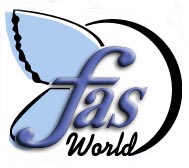
FASWORLD
the international alliance promoting the awareness of
Fetal Alcohol Syndrome and related disorders
presents
HOW TO DO FAS DAY
Online Manual for International FAS Awareness Day 2000
Prepared by Bonnie Buxton, Brian Philcox, and Teresa Kellerman
co-founders of FASWORLD, an international aliance formed
to raise global awareness about the dangers of drinking alcohol during pregnancy
and the special needs of individuals affected by prenatal exposure to alcohol.
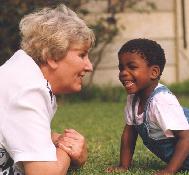
Vivien Lourens of Cape Town, South Africa
with daughter Tisha, FAS
|
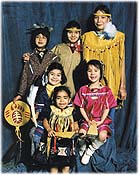
Children of Kim Meawasige,
FAS Day volunteer in Toronto
|
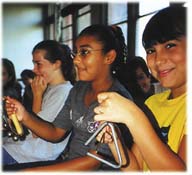
Children at Queen of Apostles
School in Toledo, Ohio
|
"I have read that the oscillation of butterfly wings in Brazil may set off storms in Texas."
--Janette Turner Hospital, The Last Magician
Sponsored by FASWORLD.COM
Download this manual here - 500k
The manual can be viewed offline by clicking on the file named "FASDAYmanual.htm"





1. What is FAS Day?
FAS Day is the short name for International Fetal Alcohol Syndrome Awareness Day, which was observed for the first time on September 9, 1999, with a "Minute of Reflection" at 9:09 a.m.
It came about because a number of people on the online support group "FASlink" were feeling frustrated about the lack of awareness by professionals and the general public about FAS.
We were trying to figure out how to make the world more aware that woman should not drink in pregnancy - and also inform the world that millions of people throughout the world are suffering from brain damage caused by alcohol before they were born.
Twenty volunteers from around the world began working together to build awareness, and by September 9 we had 80 volunteer coordinators. On September 9, 1999, events were held in communities across Canada and the U.S., and in South Africa, New Zealand, Germany, and Sweden. We also had individual volunteers in Australia and Italy. All of this was accomplished with volunteers and no financial resources.
Our international butterflies really did cause a storm. The event generated enormous local media and on September 10, 1999, we decided to do it again in 2000 - only bigger and better!
2. What is the Bell Concordance?
(From the Oxford English Dictionary)Concordance: 1. The fact of agreeing or being concordant; agreement, harmony...4. An agreeable or satisfactory blending of musical sounds or notes; harmony.)
On Sept.9, 1999, bells around the world marked the "magic minute" at 9:09 a.m., and we named this ringing of bells, "The FAS Bell Concordance." It was so successful that other organizations have picked up this term and copied it!
Bells ranged from the historic 56-bell carillon in Cape Town, South Africa, to tiny bells rung by school children in Toledo, Ohio, and wind chimes and rain sticks in Sioux-Lookout, Ontario.
Read Participating in the Bell Concordance.
3. Why observe FAS Day?
FAS Day provides an opportunity to build awareness and understanding of FAS in your own community. Newspaper, radio and TV reporters who would otherwise be indifferent to the FAS story become interested when we provide a reason for them to inform the public.
In 1999, our volunteers found that the months leading up to FAS Day, and the weeks and months afterward also helped them to build important permanent contacts in their community -- with professionals, politicians, local government agencies, media -- and, most important, other families who had also been knowingly or unknowingly struggling with FAS. The effects of FAS Day lasted well past the day itself, and many of us will be building on last year's contacts as we plan this year's events.
Yeah, but....
It's difficult when you are the only person in your community who seems to know anything about FAS. If you're a parent, you're burned-out and reeling from crisis to crisis because of your child's problems. Yet, a number of people in this situation did manage to set off some ripples of awareness.
For example:
Carol Ann Allen in Cape May, New Jersey - adoptive mom of five children with FAS -- and Carlyn Graham hosted a successful open house in Carol's home. Carol Ann and Carlyn managed to get a state proclamation from the Governor of New Jersey along with a civic proclamation.
Another parent, Claudia Barker in Bastrop, Texas, wondered what on earth she could do for FAS Day. She got in touch with Double Arc in Austin, intrigued a number of energetic Texans, and on September 9, found herself speaking to a group of teachers at a FAS Day event in San Antonio -- held as a result of her involvement. One of Claudia's recruits, parent Marlo Kaskoto, took on the job of getting a Texas state proclamation, numerous civic proclamations, and the ringing of the carillon ringing at University of Texas at 9:09 on FAS Day. Having made many excellent personal contacts as a result of her work, Claudia wrote on September 10, "FAS Day did way more for me than I did for FAS Day."
Trudy House of Hastings, Nebraska, managed to get a state proclamation from Governor Mike Johanns, and found herself on the steps of the governor's mansion being interviewed by the media.
Frances Brown on the tiny island of Kitkatla, a isolated native community in northern British Columbia, planned a community breakfast on September 9, and as a result the island's children held a protest March on December 9, urging their parents not to drink over the Christmas holidays.
Shiona Watson in the small community of Acton, Ontario, captivated ninth-graders at a local high school and managed to place a story in the local newspaper.
4. Some Worldwide Events on FAS Day '99
Here are some more events as FAS Day moved around the world -- -- feel free to borrow ideas.
Aukland, NZ: Breakfast for FAS supporters, Minute of Reflection bells ringing in nearby Mt. Albert Methodist Church. Events also held in Wellington, Hamilton and Invercargill.
Cape Town, South Africa: program outside historic 37-bell War Memorial Carillon, which rang when Nelson Mandela was released from prison.
Kiel, Berlin, Flensburg and Hamburg, Germany: posters, buttons, info stand in town centre; information evening for Social Services, teachers, physicians; famous restaurant giving free nonalcoholic drinks to pregnant women all day long.
Iqualuit, Nunavut, Canada: events included church bells, art exhibit featuring soapstone carving donated by famous artist Ookpik Pitseolak, showing drinking mother with baby in Aamouti@ (parka hood.)
Toronto, ON, Canada: program inside Metropolitan United Church included international lullabies on church carillon, native drum singer/elder offering prayer in English and Ojibwa, keynote address by Dr. Carolyn Bennett, federal Member of Parliament.
Sioux Lookout, ON, Canada: program in local park featuring sharing circle, prayer by First Nations elder, Minute of Reflection with wind chimes and rain sticks.
Kenora, Keewatin, Jaffrey Melick, ON, Canada: poster distribution to doctors= offices, three-level curriculum offered to teachers.
Toledo, OH, U.S.A.: Day-long activities included hot-air balloon with words on it, AFAS: THE HIDDEN PLAGUE@ and matching yellow AHidden Plague@ T-shirts.
Minneapolis, MN, U.S.A.: 9:09 a.m. bells included two carillons, City Hall, three cathedrals, two other churches, followed by large rally and speeches outside State Courthouse.
San Antonio, TX, U.S.A.: Day-long information program for teachers and others concerned with FAS, included presentations from FAS Day volunteers, Claudia Barker, and Dr. Bob Clayton.
Austin, TX, U.S.A.: program built around the 56-bell Kniker Carillon at University of Texas.
Tucson, AZ, U.S.A.: 9:09 a.m. bells at St. Augustine Cathedral; outdoor program featuring two young people who struggle daily with FAS.
Lakeland, AB, Canada: five communities participated in day-long events, including poster blitz, mall display, bars offering Apregnant pause@ nonalcoholic drinks for pregnant women, church bells ringing, junior high school students making FAS Knots, proclamations in all five communities.
Red Deer, AB, Canada: all-day mall displays, use of FAS brochures as place-mats in local restaurants.
Brooks, AB, Canada: A 9-block walk to symbolize the 9 months of pregnancy, with Atrimester@ information provided every three blocks. At the end of the walk the handouts were assembled into a picture of a healthy bouncing baby.
North Vancouver, B.C., Canada: Co-ed sweatlodge held by AChange of Seasons Society@ with traditional pipe ceremony, prayers at 9:09 a.m., on Capilano Reserve.
Port Orchard, WA, U.S.A.: Bells of United Methodist Church, at the edge of a scenic hilly bay overlooking the Pacific, plus prayer ceremony. ABells were heard for miles and miles.@
5. Getting started
It helps if you have at least one "partner in crime." You can accomplish a lot with the support of your spouse or partner, a friend or neighbour - possibly someone who doesn't have to cope with a child with FAS. And brainstorming with someone as committed as you are can be fun.
If you belong to a support group, enlist all of them to help. If you are not a parent, but have a job related to FAS -- as teacher, social worker, etc. -- you are really in luck. Even a small committee of six people can work miracles.
Now, make a list. Who else might be interested in helping? Think about your own best contacts -e.g., relatives, neighbours, other parents, co-workers, members of your faith community, professionals who have indicated an interest in learning more, a local service club interested in issues relating to children.
Also make a list of people in the media who may be interested in promoting your cause. Begin building a file of local reporters who write or broadcast on social issues. Do you know anyone who knows any of these people?
When you have a sense of what kind of community support, and what size of committee you will have, you can begin to plan your own awareness event. Even a small event can build ripples!
6. Online Support
Feel free to brainstorm with members of the FASDAY list at http://www.egroups.com/group/FASDAY. If you would like to join the list, send an email to FASDAY-subscribe@egroups.com.
People who participated last year will have many suggestions, and will offer support if you simply send questions to the general list. All of last year's posts are archived and you may find ideas there. Members of the mail list can access the archived messasges at this URL: http://www.egroups.com/group/FASDAY. As well, check in frequently onto the website http://www.FASWORLD.COM and click on "FAS-breaking news."
7. FASDAY Proclamations
Your first step should be to take steps to get a civic proclamation, and if you live in the U.S., write for a state proclamation. In 1999, FAS Day volunteers all over the world managed to get civic proclamations, and U.S. volunteers also acquired 14 state proclamations. Here's a sample letter , written to the mayor of the City of Toronto, Canada, plus an update of 1999 Toronto proclamation drafted with the help of the city's protocol office. Versions of the 1999 proclamation were used in many towns, cities and states in the world.
(Date and address)
Mayor Mel Lastman
Toronto City Hall
100 Queen Street West
Toronto, ON M5H 2N2
Dear Mr. Lastman,
I am writing to request that you officially proclaim International Fetal Alcohol Syndrome Awareness on September 9, 2000. We were pleased that you proclaimed International FAS Day on September 9, 1999, and would be grateful if you could read this year's proclamation at our observance on September 9 at 8:30 a.m. at Metropolitan United Church.
Fetal Alcohol Syndrome is the leading cause of mental retardation in Canada and the industrialized nations of the world. FAS is not just a "disease of the week" but a major root cause of numerous social disorders, including the homelessness/street kid issue that currently plagues Toronto. People with FAS also are at high risk of learning disabilities, early school drop-out, juvenile delinquency, drug addiction and alcoholism, mental illness, crimes against property, vandalism, child and spousal abuse, unemployment and poverty. Some researchers believe that as many as 1 in 100 people are affected with fetal alcohol disorders. The lifetime cost to taxpayers for treatment of individuals with FAS is estimated to be more than $2 million per person.
My husband Brian Philcox and I are coordinators of "FASWORLD," an informal alliance of parents and professionals around the world who are working to build awareness of the dangers of drinking in pregnancy, and the desperate plight of individuals with FAS and their families.
Why September 9 at 9:09 a.m.? On the ninth minute of the ninth hour of the ninth day of the ninth month, our alliance asks the world to remember that during the nine months of pregnancy, a woman should not drink alcohol. We also want the world to remember those millions of individuals who will not reach their genetic potential because their mothers drank in pregnancy. People around the world are working at getting their local bells to ring at 9:09 a.m.
Various organizations with an interest in FAS issues are supporting us in our FAS Day program here in Toronto. Among them are Breaking the Cycle (which works with pregnant women with alcohol/drug issues) and Native Children and Family Services (which works with native street youth.)
I've enclosed documentation about FAS and the FASWORLD alliance. My husband and I are adoptive parents of Colette, now 19, who was diagnosed with Fetal Alcohol Effects in November, 1997. Colette spent most of 1997 on the street, surving by squeegeeing and addicted to crack. We now believe that many squeegee kids struggle with undiagnosed fetal alcohol disorders, and would welcome an opportunity to meet you and other City Council members who would be interested in learning more about FAS.
We would welcome any assistance you and Council can give us in encouraging the people of this great city to ring every bell in Toronto at 9:09 a.m. on September 9. Also enclosed is a "FAS Knot," our symbol of connection around the world.
Yours truly,
Bonnie Buxton
|
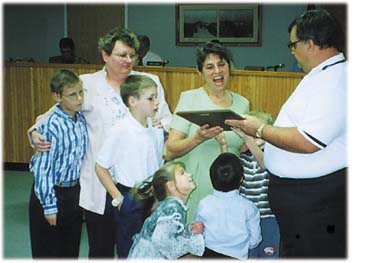
Carol Ann Allen and her family
accept the Proclamation from
Mayor Charles Leusner of Cape May County, New Jersey
Here is an updated version of the Canadian 1999 proclamation, worked out with the protocol officer at City of Toronto. Feel free to adapt it to your needs.
|
PROCLAMATION
Fetal Alcohol Syndrome Awareness Day
September 9, 2000
WHEREAS: children are our most important resource and it is our responsibility to care for, nurture and protect them; and
WHEREAS: statistics indicate that individuals with Fetal Alcohol Syndrome and Effects (FAS/E) in Canada and industrial nations throughout the world, face the risk of mental retardation or learning disabilities, early school drop-out, homelessness, addictiveness, trouble with the law and mental illness; and
WHEREAS: to reduce the incidence of FAS/E, it is essential that women in pregnancy are provided with support and information; and
WHEREAS: parents, professionals, individuals living with FAS/E and other people around the world will observe the second International FAS Awareness Day on Sept. 9, 2000, with a Minute of Reflection at 9:09 a.m.
NOW THEREFORE: I, Mel Lastman, Mayor of the City of Toronto, on behalf of Toronto City Council and the more than 2.3 million people of our great city, do hereby proclaim September 9, 2000 as "Fetal Alcohol Syndrome Awareness Day" in the City of Toronto. I encourage everyone to act with compassion and understanding towards those individuals whose lives were affected by alcohol before they were born.
(signed) Mel Lastman, Mayor
|

Steve Neafcy accepting the Proclamation from
the Mayor of Tumwater, Washington
This is the Proclamation written for Arizona, and can be adapted for other states or cities in the United States:
Office of the Governor
PROCLAMANTION
*FETAL ALCOHOL SYNDROME AWARENESS DAY*
WHEREAS, healthy children are the most important resource in the great State of Arizona; and
WHEREAS, Fetal Alcohol Syndrome is the leading cause of mental retardation in Arizona, the United States, and all of western civilization; and
WHEREAS, as many as 1 in every 100 individuals in these United States may be adversely affected by prenatal exposure to alcohol; and
WHEREAS, Fetal Alcohol Syndrome and Effects are a root cause of numerous social disorders, including learning disabilities, juvenile delinquency, school drop-outs, homelessness, unemployment, mental illness, and crime; and
WHEREAS, economists estimate that each individual with Fetal Alcohol Syndrome and Effects will cost the U.S. taxpayer nearly two million dollars in his or her lifetime; and
WHEREAS, people around the world will be observing the first International FAS Day on September 9, 1999, in order that on the ninth day of the ninth month of the year, the world will remember that during the nine months of pregnancy a woman should abstain from alcohol,
NOW, THEREFORE, I, Jane Dee Hull, Governor of the State of Arizona, do hereby proclaim September 9, 1999 as
*FETAL ALCOHOL SYNDROME AWARENESS DAY*
in Arizona, to promote awareness of the effects of prenatal exposure to alcohol, to increase compassion for those individuals so affected, to minimize further effects, to ensure healthier communities across Arizona in the future.
IN WITNESS WHEREOF, I have hereunto set my hand and caused to be affixed the Great Seal of the State of Arizona
______________________________
Jane Dee Hull
GOVERNOR
DONE at the Capitol in Phoenix on this _______ day of _____________ in the year of Our Lord One Thousand Nine Hundred and Ninety-nine.
ATTTEST:
______________________________
Betsey Bayless
Secretary of State
|
8. Participating in the Bell Concordance
The Bell Concordance is an optional event, relatively easy to organize, and many were held last year.
This can be done in numerous ways - e.g., inside or outside a church, with ringing church bells or carillons; in a school or schools, with children ringing tiny bells; in a park, ringing wind chimes. Last year at 9:09 a.m.,, bells marked the "Minute of Reflection" all the way from northern Canada to South Africa and New Zealand.
You can participate in this even if you are the only person in your community who knows what Fetal Alcohol Syndrome is!
The 54 bells in the carillon of Metropolitan United Church, played by carillonneur Gerald Martindale, are among the numerous bells scheduled to ring around the world on this special morning. The carillon is the largest musical instrument in existence, and even in a large, noisy city, its music can be heard for several blocks. Other carillons ringing are in Hastings, NE, Minneapolis, Rochester, Chicago, Austin and San Antonio, TX., and in Cape Town, South Africa, where citizens will hear the historic 37-bell War Memorial Carillon, which rang joyfully on Nelson Mandela's release from prison.
There are about 600 carillons throughout the world, and we want even more to ring during this year's Minute of Reflection. To find out if there is a carillon near you, go to http://www.gcna.org/, the most complete and accurate listings of carillons in North America, and also check out www.cs.yale.edu/~douglas-craig/bells and http://soda.csua.berkeley.edu/~maestro/stat.htm.
Gerald Martindale, carillonneur at Torontoís Metropolitan United Church (email:geraldm@planeteer.com), can help put you in touch with a local carillonneur (carillon player), if there is one. Gerald, who has very kindly offered to play again this year, is building on last yearís concert of international lullabies and would be pleased to share this with other international carillonneurs.
We have come up with the bell idea as there is a purity about bells that reminds us of the innocence of children. As well, bells are historically associated with warnings, alarms, marking important moments, and simply pealing for the joy of connecting with the community. FAS Day is all of these things.
The FAS Bell Concordance is quite simple, and you can do most of the work on your phone. Is there a tower with a hand-rung bell in your community? This could be an older church, a city or county hall, state or provincial building, or part of a college or university campus. Unfortunately many church bells are now rung by computer, making it difficult to ring the bells off-schedule, and this may be the case in your community.
Find out who is in charge of getting that bell rung, and ask that person to have the bell rung for one minute at 9:09 a.m. on September 9. You can download the FAS Day information from FASWORLD.COM and present it to this person. If this building is a church, you may wish to speak briefly to the congregation on one of the Sundays before FAS Day, and explain why the bell will be ringing at 9:09 this year.
You may want to have a small program in the church or near the bell tower, for 20 minutes to a half-hour before 9:09 a.m. Notify your child=s school, friends of FAS and related organizations that you think would be interested, e.g., your local ARC (U.S.) Association for Community Living (Canada), Exchange Club, homelessness and anti-poverty coalitions, John Howard and Elizabeth Fry societies B and every single friend or relative you can convince to come.
No bells in your community? Use other musical instruments of your choice: drums, cymbals, whatever. One FAS Day supporter shook her grandmother's old school bell -- and a group in a small northern Canadian community approached their local fire department!
This should be a happy occasion. Those ringing bells - or whatever else you choose - will be a powerful auditory reminder that we are all connected to the planet, and each other. They are a statement that FAS can be beaten. Last year, by working together in that "magic minute," we began to change the world. In 2000, we will build on last year's work.
9. More Ideas for Minute of Reflection
No Bell? More Suggestions For 9/9, 9:09 a.m.
Everyone participating in FAS Day is invited to share in the "Minute of Reflection" -- 9:09 a.m. on September 9, as it goes around the world. In this magical moment - the ninth minute of the ninth hour of the ninth day of the ninth month - we want to get out the message that in the nine months of pregnancy, while breastfeeding or planning to conceive, women should not drink alcohol. In this minute, we also want the world to remember those millions of people around the world who are living with fetal alcohol disorders.
If a large bell or carillon is not accessible or appropriate, participants can do many things to observe that special minute. -- in accordance with their own cultural background or religious beliefs.
The Minute of Reflection symbolizes the worldwide circle of community which links all of us who care about FAS, all of us who are working towards prevention, all of us who are trying to help children and adults with fetal alcohol disorders reach their full potential. Here are nine more suggestions for observing the Minute of Reflection. If you have other ideas, please share them with us.
* Alone or with others, sit outside quietly and listen to the birds, or the wind blowing through the trees, or water lapping against the shore of a river or lake. You may want to focus on the wonderful gifts and strengths of the person (s) with FAS/E in your life.
* Say a prayer or recite a poem appropriate to your beliefs, such as the lovely FAS Day invocation written for Toronto's 1999 observance by Sister Eileen Power; or the nonreligious poem "The Integrity of Hope," by Michael Kami, both in Section 12. (We're currently looking for other suitable selections and would welcome suggestions.)
* Sing a song or hymn. (A musical member of FASN Toronto suggests Oscar Peterson's "Hymn to Freedom" or even singing "Rockabye Baby" as a round. We welcome other suggestions.)
* Listen to an excerpt of your favorite music. (Again, any suggestions?)
* Play a musical instrument, alone, or with fellow musicians -- or ring tiny bells and "triangles" as the children of Queen of Apostles School, Toledo, OH did at 9:09 a.m. on September 9, 1999.
* Sit in a circle and share some pure spring water with people you care about.
* Place a long-distance phone call to a special friend who is equally committed to the FAS issue: you could even make it a three-way or teleconference call.
* You may find 9:09 a.m. inconvenient and may prefer to mark the Minute of Reflection at 9:09 p.m., and light a candle to symbolize both the flame of your love for individuals living with FAS, and your burning desire to eradicate this preventable disease.
* Simple silence.
Each person with FAS is different, and those of us who love them respect their differences. Respecting each other while working together is what FAS Day is about.
10. The FAS Knot
In 1999, volunteers from New Zealand and South Africa to Arctic Alaska and Canada's northern territories used the FAS Knot as a symbol of our worldwide campaign to inform the world about Fetal Alcohol Syndrome and related disorders.
This piece of knotted cord was designed in memory of Abel Dorris, 1968-1991, whose brief and poignant life resulted in the groundbreaking 1989 book about Fetal Alcohol Syndrome, "The Broken Cord," written by his father, Michael Dorris, 1945-1997.
The broken cord may refer to the umbilical cord, the spinal cord, the nervous system, the cord between the generations, or the cable on an elevator. Michael Dorris wrote that if we back off on our children with Fetal Alcohol Syndrome or Fetal Alcohol Effects, they will sink like an elevator once the cable is snapped. Ten years after Dorris's book, a loving community around the world reconnected the broken cord, developing the FAS Knot as our symbol.
Each knot can be made easily and cheaply in less than a minute, and a small group can whip up several hundred in an hour or so. The cord is tied in a square knot, sometimes called a reef knot, the favored knot for reconnecting a broken line or cord. The knot is stronger than the cord itself, and cannot be broken or snapped. In the U.S. and Canada, some groups have sold the knots for $2-$5, or asked for donations.
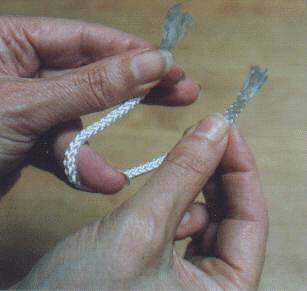
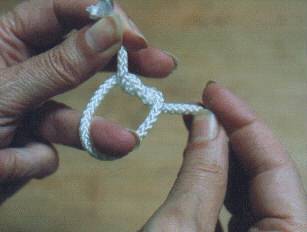
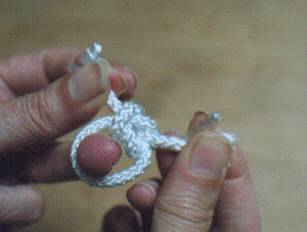

To make the FAS Knot, volunteers in the U.S. and Canada have been using an eight-inch piece of 3/16" white cord, available in most hardware stores for a few cents per foot. Volunteers in New Zealand and Germany have made smaller and more discreet FAS Knots, using thinner cord.
Whatever size you choose, make a circle approximately the size of your thumb (possibly smaller if you use a thinner cord), then tie right over left and under; left over right and under. It should look like two loops intertwined. Using a straight pin or safety pin, pin this to your lapel or other garment.
By choosing a cord instead of a ribbon, we are separating ourselves from all of the other disorders. We are not just another cause trying to raise money -- we represent those millions of individuals and their families who have gone unrecognized, unidentified, neglected on this continent and throughout the world.
The circle symbolizes the womb, a baby's head, the human brain, the earth. And we, a planet-size network of people who care about people living with FAS, are the knot that will make them whole. If women did not drink in pregnancy, FAS would be totally eliminated. Our long-range goal is to rename this small piece of cord, "The FAS Not!"
The FAS Knot was designed by Bonnie Buxton and Brian Philcox, trademark pending. We encourage groups supporting FAS/E endeavours to use it for promotion or fund-raising, and ask only that you notify us before doing so. Write to us at 250 Scarborough Golf Club Road, Toronto, ON M1J 3G8, fax us at (416) 264-8111, or email us at ogrady@pathcom.com
11. Reaching the Media
A. Issue a Press Release
Some tips:
- Make sure that your name, phone number and email are right at the top of the release.
- Remember to lead with the old newspaper "Who-what-where-when-and why," OR come up with a quote or fact that will grab the reader.
- Use quotes from other people involved, where appropriate.
- Make sure you send it to the right person at the newspaper, radio or TV channel you are trying
to reach. It's helpful if you monitor this medium so that you know you're hitting the right department. Don't be afraid to phone or email for more information on who your right contact might be.
- If you have any contacts with media people, no matter how remote, use them. For example if your brother-in-law's next door neighbour Buzz Smith is the person you are trying to reach, attach a letter saying:
Dear ___________________:
My brother-in-law George Brown suggested that you are the right person to contact at the Globe...
- Make a follow-up phone call to make sure the appropriate person received your press release.
- Reaching the right person is difficult in the days of voice-mail...you may want to write a friendly and positive mini-script for yourself. "Hi Buzz, this is Sherry at the Fetal Alcohol Support Network. On September 9, Huntsville will be joining the worldwide FAS Bell Concordance. Six churches and the Town Hall bell are going to be ringing at 9:09 a.m to remind the world that during the nine months of pregnanchy a woman should not drink. Did you receive the press release I sent you? Please phone me at 555-7736."
************
Sample Press Release (from Marlo in Texas):
|
International FAS Bell Concordance
In One Magic Minute, We Can Change the World: 1999/9/9 9:09am
For Immediate Release
Tuesday, March 21, 2000
Contact: Marlo Schaar-Kaskoto
email: mkaskoto@msn.com
(512) 990-1604
Austin, Texas: The 56-bells Kniker Carillon University of Texas will join in the International FAS Bell Concordance in support of the First International Fetal Alcohol Syndrome Awareness Day (FAS DAY) on September 9.
Marlo Schaar-Kaskoto, Austin organizer of FAS Day, explains that "On the ninth minute of the ninth hour of the ninth month of 1999, bells will toll throughout the world to begin a minute of reflection by parents, caregivers and professionals who will be reminding others that women should not drink alcohol during their nine months of pregnancy."
Tom Anderson, longtime UT carillonneur, will toll the bells 9 times and follow with an international folksong. "FAS Day coordinators chose bells to mark the minute of reflection because bells are historically associated with warnings, alarms, happiness, marking important moments, and simply pealing for the joy of connecting with the community," says Ms Schaar-Kaskoto, mother of a three-year-old son with Fetal Alcohol Effects (FAE).
She adds, "The tolling of the bells will symbolize the tears parents have cried for our children, the hope for the future, and the joy of knowing the global community is working together to end this tragedy by promoting worldwide awareness, education , and prevention efforts."
Close to 100 volunteer coordinators from 8 countries around the world have joined together to promote awareness regarding the damaging effects of drinking during pregnancy. These effects include growth retardation, physical, mental and behavioral disorders, central nervous system impairments; such as developmental delays, small head size, speech and language delay, and facial abnormalities.
"Fetal Alcohol Syndrome is 100% preventable by abstaining from alcohol during conception and pregnancy," says Larry Camp, Executive Director of the Texas Office for Prevention of Developmental Disabilities. "However, many pregnant women are still not aware of the dangers in consuming alcohol. According to the Center for Disease Control, FAS is the leading cause of birth defects today. As many as 1 in 100 Americans may be living with the affects of maternal drinking in pregnancy. Lifetime cost to the taxpayers for individuals with FAS is estimated at almost $2 million per person."
International FAS Day, on September 9, 1999 has been officially proclaimed by the City of Austin and the City of Pflugerville, along with numerous towns, cities, and states, across the U.S. and Canada. It is locally endorsed by the Fetal Alcohol Syndrome Consortium, Texas Office for the Prevention of Developmental Disabilities and Austin Metropolitan Ministries.
|
************
B. How to do an Interview
For those of you who will be interviewed by press and/or reporters, here are some Interview Boundaries and Ideas to Help You Discuss FAS/E
by Teresa Kellerman (©1999 FAS Community Resource Center)
.
* Use "people first" language. Put the person first and the disability second. Please do not refer to our children as FAS kids. They are CHILDREN with Fetal Alcohol Syndrome or people with alcohol related neurological disorderss. We are parents who cope with FAS/ARND.
* Avoid judgment. Try not to lay blame on the birth mother. Instead of saying "child abuse in the womb," say "exposure to alcohol before birth." If we are going to blame anyone, we can blame the alcohol industry (which has a great deal of control over congress and the television industry).
* Be positive. People are more likely to listen to and remember a message that is phrased with positive language rather than negative language, even if the negative message is an important one, like "Don't Drink During Pregnancy." Instead, try such positives messages as "It is best for the baby if mom stays alcohol free."
* Know your facts. If you are going to make statements about how prevalent FAS is, have your fact sheet nearby with sources to back up what you say. A good single source of stats and facts can be found in the FAS QUIZ which has the sources right there on the answer page. This can be handed to the reporter after the interview. (prints out two pages when margins are set to 3/4")
http://www.come-over.to/multiplechoice/fasquizprintout.htm
* FAS is the leading known cause of mental retardation in western civilization (US and Canada, Europe, Australia). Incidence is 1/500 according to the World Health Organization. But FAS is NOT the leading cause of MR in the world. That would probably be malnutrition and dehydration in third world countries. Prenatal alcohol exposure is *probably* the leading cause of neurological disorders (FAS and FAE), seriously affecting 1 out of 100 people in the U.S. (Streissguth).
* Alcohol causes more damage to the brain of the developing baby than any other substance, including heroin, marijuana, and cocaine. (Institute of Medicine 1996 Report to Congress)
* Pass out posters. Use the mini-poster designed just for FAS Awareness Day. The "Be Good To Me" flyer has a nice positive message on it. You can add your own name and number as a contact person. (one inch margins) http://www.come-over.to/FAS/fasdayposter.htm Full size posters can be ordered from the FAS Store at http://www.come-over.to/FAS/store/
* Wear your FAS KNOT. It will only take a minute to make. Be sure to print out the paragraphs that explain the story behind it. http://www.come-over.to/FASWORLD/fasknot.htm
* Plan ahead. Be prepared to hold an informational presentation or support group gathering for those who wish to learn more or who would like to connect with others involved with caring for individuals with FAS/FAE. It would be nice to already have a free library room reserved for this purpose and hand the info to the reporter. Helping isolated parents connect with other isolated parents will make a HUGE difference for kids in your community, and will give substance to group efforts to change policies and laws locally.
* Use just a few handouts. Too much paper will just be thrown away and not read. Use the interesting flyers with the pictures. Several to choose from here: http://www.come-over.to/FAS/brochures/
*
Direct them to the Internet - that's where all the action is. Be sure to tell them about FASLINK and other Internet support groups http://come-over.to/FAS/fasonline.htm and give them the websites for FADU http://depts.washington.edu/fadu/ and FASWORLD http://www.come-over.to/FASWORLD. In Canada, refer them to Bruce's site http://www.acbr.com/fas/. In the US, refer them to the FAS Community Resource Center http:/www.come-over.to/FASCRC
*
Be yourself. Even if you donít have a PhD or an MA, you are an expert when it comes to FAS. If you know your subject, then that is all the confidence you need. If you donít know enough about it to feel comfortable, then turn the interview over to someone else.
************
C. Public Speaking
Speaking of butterflies -- Keep doing awareness work long enough, and you're going to be asked to give a speech. It's nothing to fear! Here's a note that Brian Philcox sent to Ann Gibson of Germany in 1999 when she found herself scheduled to make a speech about FAS. Brian is an accomplished speaker, and speaks about once a week to various Rotary groups in southern Ontario, Canada:
Hi Ann -
I ve been following your correspondence from Germany on the FASDAY project with great interest and awe. You are certainly making things happen there. In view of your seeming hesitation about taking on some speaking responsibilities, I d like to make a few comments and suggestions. Apart from my work as a personal coach, I also teach Business Communication at a local community college, so I thought I d share some of the techniques and insights I use with my students.
Some things worth remembering:
- You know your subject better than anyone else in your audience.
- Your audience wants you to succeed they're rooting for you.
- It's normal to have butterflies when speaking (the trick is to get them to fly in formation!).
Here are some insights and suggestions that will help you say what's on your mind succinctly, and with impact, without rending your emotions with unfounded fears.
1. Don't hesitate: if there is something you want to say about something, just do it. The words will come to you before you know it. The longer you hold back the harder it is to speak up.
2. Nervous? That's normal. Actually, hardly anyone else will notice and the nervous response will kick in your adrenaline, giving you strength when you need it most. Anyway, no one really cares if you are a bit nervous.
3. Be declarative: in other words, state what you think right up front. Say, "FAS is the most devastating issue our society has to deal with." or "Harry has left out an important aspect of the problem." remember to always speak from the heart and don't be shy to put an emotional quality into your voice. Let your energy reflect how much you care.
7. Think in threes: follow your opening statement with three reasons or aspects why you have taken the position you are endorsing. Use personal examples as well as generic or statistical ones. For example, "FAS is the single largest reason for brain damage among newborns." or, "If we continue to ignore the impact of this issue we will continue to have more homeless, more unemployables and increasing costs to society at large." Three aspects are easy for you and your audience to remember. Don't belabour the issue.
8. Bind your comment with a recommendation: having established your stance on the subject at hand, explain what you expect to be done to support your concerns or interests. Never be afraid to ask for support and you're more likely to get it if you ask people to do something specific.
9. Use personal anecdotes: where you have had experience with the issue, briefly outline what happened and how you feel about it.
10. Use humour: particularly when the joke is on you, you will endear your audiences to your cause when you reveal your own vulnerability.
11. Use your body: stand up and make sure that you can be seen and heard. Make gestures that emphasize the points you are making. And smile, because, even if you are disagreeing with someone or something, your voice will be warmer and friendlier, and you will attract more supporters to your position.
12. Be brief: everyone has other things to do or issues to raise. Don't lose their support by being long-winded and boring.
13. Be prepared: especially when you have reasonable notice of when you will be speaking, there's no excuse for not having all your arguments at your fingertips. Start making notes now of ideas that come to you. Keep a notebook handy at all times (ideas do come at the oddest moments) and don't worry about order or significance at this first stage. After you have as many points in your list as you think are of top importance (remember you re not attempting to tell everyone everything about FAS all at once) then you can begin the process of organizing your thoughts in sequence:
- Tell them what you're going to tell them
- Tell them
- Tell them what you ve told them
That may sound glib but it is the most effective way you have to get your point across. In effect, you briefly open your remarks with an overview statement which could include some startling statistics and what you would like to see happen in your community. Then go into some details with anecdotes. To conclude, summarize what you have just told them and restate your goal.
If you can, don't read from a script. Use a card with key points on it so that you don't leave anything out. You won't have any trouble doing it this way if you do the most important thing of all: practice. Rehearse your remarks in front of the mirror, while you're in the shower, in front of friends and family, in the car, anywhere.
Once you have the basic structure of your remarks in place, start practicing and practice every day. When the time comes for your presentation, it will be just like talking to the neighbours. Do let me know if any of this is confusing or if you have any questions at all.
Keep up the great work for FAS. --Brian
Keep these guidelines in mind whenever you have an opportunity to speak up at any kind of gathering for any kind of reason. Better still, find a reason to speak up as often as possible so that you will get as much practice as you can. You will find that your comfort level will grow with every occasion that you do speak out and friends and strangers will be complimenting you on your articulate erudition.
Brian is a personal life coach. If you have to give a speech, and those butterflies are making your stomach do flip-flops, feel free to email Brian at coachbrian@sprint.ca
************
Here's something else we found online:
The Top 10 Tips to Delivering a Perfect Speech
You don't have to possess a loud, sonorous voice, a pearly white
smile, or a wild charismatic stage presence to give a great speech; all the
pleasant packaging and confidence is useless if the speech itself is
illogical, boring , or poorly written. Consider these tips when preparing your
next presentation:
1. Consider the format: Will you be the sole speaker or one of a number of speakers on
a panel? The answer will guide your preparation efforts.
2. Make sure you are comfortable and familiar with your topic: Never speak on a topic just because it's popular if you don't
know it well.
3. Determine the purpose of your speech: What is it you want the audience to walk away with as a result
of your presentation?
4. Can the topic be covered in the time allotted to you? You may have to negotiate for more time, choose a different
topic, or deliver only 1-2 ideas related to the topic.
5. Pay attention to the details: Assume nothing. Make sure you and your sponsor are on the same
page regarding every detail of the event -- date, time and place,
pronunciation of names, etc.
6. Know the organization: Find out all you can about the organization and its membership
before you accept the invitation to speak. Guide your writing efforts to the
audience.
7. Do the appropriate research: Before you begin to write your speech, make sure you have a
solid working knowledge of the subject from experience, interviews and
reading.
8. Brainstorm: Get together with a small group of people in an informal
setting and talk about the subject, throwing around ideas and sharing
insights.
9. Create an outline: A list of points you want to cover will guide and organize your
speech presentation. Pare down the list and group similar points under a
common subheading.
10. Establish a cause-and-effect for maximum impact: Give the cause of the problem, describe its effect, then
suggest a solution. To do this effectively, your topic and supporting
materials need to be in sync.
by Carmen Stine, PhD(C), who can be reached at
coach@welcometoyourlife.com, or visited on the web at http://www.welcometoyourlife.com
************
D. Putting a Face on FAS/E
Putting a face to the disability can go along way towards building awareness. Some of us are in a position to be able to tell our family's story, and we have the support of our loved ones with FAS/FAE in doing so. For others, confidentiality is an issue, or our family members do not want to be identified. In this situation, it might be helpful to find other families who have the freedom to speak out. It might also be possible to disguise your identity, using a different name, and, if interviewed on TV, use camera or postproduction techniques that blur your identity. Members of the media prefer not to do so, but they might, if your story is strong enough. And many of us have lived with exceptionally strong stories - the daughter who sells her body for drugs; the son who is a repeat offender. Whatever your decision, in how far you can "come out," we respect you.
12. Ideas and Examples
What Was Done in Toronto in 1999
(Feel free to borrow whatever you like.)
The program: we printed one-page scrolls on a regular 82@ x 11" page. We rolled them up, and fitted them through the loop in the FAS Knots we had been making all summer.
These were placed in a basket as people came into Metropolitan United Church. Beside the basket was a box of pins. A nearby volunteer pinned the FAS Knots on people as they arrived.
For whatever reason, the program did not list the names of all our participants, including Sister Eileen Power, who wrote and delivered her wonderful FAS Day invocation, and keynote speaker Dr. Carolyn Bennett, MP - an oversight on our part. (Maybe because we did all this in the middle of the night?)
The scroll said:
|
BELLS AROUND THE WORLD
The 54 bells in the carillon of Metropolitan United Church, played by carillonneur Gerald Martindale, are among the numerous bells scheduled to ring around the world on this special morning. The carillon is the largest musical instrument in existence, and even in a large, noisy city, its music can be heard for several blocks. Other carillons ringing are in Hastings, NE, Minneapolis, Rochester, Chicago, Austin and San Antonio, TX., and in Cape Town, South Africa, where citizens will hear the historic 37-bell War Memorial Carillon, which rang joyfully on Nelson Mandela?s release from prison.
The purity about bells reminds us of the innocence of children. As well, bells are historically associated with warnings, alarms, marking important moments, and simply pealing for the joy of connecting with the community. Our goal was to have bells in every time zone ringing at the "magic minute" at 9:09 a.m. We call this, the "FAS Bell Concordance."
From the Oxford English Dictionary:
Concordance: 1. The fact of agreeing or being concordant; agreement, harmony...4. An agreeable or satisfactory blending of musical sounds or notes; harmony.
Prelude:
Toccata for 42 Bells, by Robert Moore; Londonderry Air, Irish melody arr. Sally Slade Warner;
Carillon by Jan Wagenaar
Postlude: traditional international lullabies arr.Gerald Martindale
Brahms Lullaby by Johannes Brahms (Germany); All Through the Night (Wales);Rockabye Baby (traditional England); Hush Little Baby (U.S.);Hine e Hine (Maori from New Zealand)
A guided tour of the carillon will be available after the program,
THE FAS KNOT
This piece of knotted cord was designed in memory of Abel Dorris, 1968-1991, whose brief and poignant life resulted in the groundbreaking 1989 book about Fetal Alcohol Syndrome, "The Broken Cord," written by his father, Michael Dorris, 1945-1997.
The broken cord may refer to the umbilical cord, the spinal cord, the nervous system, the cord between the generations, or the cable on an elevator. Michael Dorris wrote that if we back off on our children with Fetal Alcohol Syndrome or Fetal Alcohol Effects, they will sink like an elevator once the cable is snapped.
The circle symbolizes the womb, a baby's head, the human brain, the earth. And we, a planet-size network of people who care about people living with FAS, are the knot that will make them whole. If women did not drink in pregnancy, FAS would be totally eliminated. Our long-range goal is to rename this small piece of cord, "The FAS Not!"
|
THE FAS DAY INVOCATION
This beautiful and inclusive prayer was written and delivered by Sister Eileen Power at last year's Toronto observance. It's freely available for anyone in the world who wants to use it. I have updated it for 2000. If you use it, please credit Sister Eileen Power, and mention that she is a teaching sister of the Congregation of Notre Dame in Toronto.
by Sr. Eileen Power, CND
O Great Spirit, Creator of the Universe, we gather on the ninth minute of the ninth hour of the ninth day of the ninth month in the first year of the New Millennium.
Our connection with our whole world is made visible in a special way today. People in every time zone gather, as we gather, to change our world. By our coming together and our working together, we will make the world better. Accept our prayers with all who are praising you this very moment and with all who will gather today.
As we begin this millennium, we are filled with hope, O Ever-Creating God, that
in the circle of life, in the cosmos, in the womb, in our hearts, your hope goes round, your strength goes round, your power goes round, your love goes round and our hearts and spirits are joined in a new birth.
We gather to intensify our awareness of the fragile beauty of life from the first moment of conception, of the privilege of the nine months of pregnancy, and of our resolve to help all children and adults with fetal substance disorders to lead happier and more fulfilling lives.
All of our words, gestures and hopes of today:
Our silence and our bells,
Our dance and our reflection,
Our words and our drums,
Our children and our knots,
Our lullabies and our resolve,
All of our words, gestures and hopes of today,
Are powerful reminders that life is your gift to us.
May the drumming of our hearts, echoing the drum of the heartbeat of the universe, be the sound of your tender love. May the knot of our connections be ever firm.
And may this special moment on this special day continue to mark the beginning of change,
for mothers, for fathers, for all children and for those yet-to-be, and for all of us who join in spirit today around this unique planet, so beautiful, so fragile, so large and yet so small.
Together, we are family.
The following poem is also appropriate to a FAS Day observance. In Toronto, 2000, it will be read by a survivor of FAS.
The Integrity of Hope
Just as the gentle flutter of a butterfly's wing
Can change the path of a hurricane
So the gentle beat of a child's heart
Can change the destiny of the world.
Children are our future and our hope.
Only they determine humanity's progress.
We must protect all children.
We must feed all children.
We must educate all children.
We must love all children.
They are we and we are they,
In a joint journey to a better future!
--Michael Kami, consultant 1993.
************
Other Ideas:
FAS AWARENESS DAY POSTER
http://www.come-over.to/FAS/fasdayposter.htm
HMTL Poster: Choose "print background" under Internet options and use one inch margins.
Add your own group or name with phone number for local contact in space provided.
http://www.come-over.to/FASDAY/FASDAY.PDF
FAS AWARENESS DAY POSTER pdf file (175 k) 8-1/2 by 11 inches.
You need Adobe Acrobat reader to view and print this file. Get it here.
************
http://www.mofas.org/events/eventtoc.htm
Ideas from Jodee Kulp's Minnesota MOFAS web site.
************
Public Service Announcements from Mary Horner
RADIO PSA SCRIPTS
(30 Seconds each)
How to submit Public Service Announcements:
1) Type each script double-spaced on your letterhead (if you have a supporting agency)
with the name of a contact person.
2) Submit scripts to radio public service directors in your community in
several weeks in advance. Your chances of getting them aired may increase if you try to
give each radio station a different script.
3) Follow up with a phone call to the public service director a few days after
you submit the scripts asking if they have arrived and if broadcast
on FAS Awareness Day will be possible.
4) If the public service director was receptive to your first phone call,
follow up with additional phone calls before FAS Awareness Dat to remind
them about the PSA.
5) If any radio stations air your PSAs, send the station manager a thank you note.
Sample live copy scripts:
Babies whose mothers drink during pregnancy are at higher risk of miscarriage, birth defects,
and mental disabilities. It is best for a pregnant mother to abstain from alcohol
for the duration of her pregnancy. For more
information about Fetal Alcohol Syndrome and related conditions, call (INSERT NAME OF GROUP) at (INSERT PHONE NUMBER).
That's (INSERT PHONE NUMBER).
If you're pregnant and you choose not to drink, your baby
will be healthier. And if you stop drinking at any
time during your pregnancy, you will improve your chances of having a
healthy baby. For more
information about Fetal Alcohol Syndrome and related conditions, call (INSERT NAME OF GROUP) at (INSERT PHONE NUMBER).
That's (INSERT PHONE NUMBER).
The next time you're drinking to your family's health, (INSERT NAME OF
GROUP) asks you to remember this: alcohol use by pregnant women is
the leading known cause of mental disabilities in newborns. No safe level of
alcohol consumption during pregnancy has been established. For more
information about Fetal Alcohol Syndrome and related conditions, call (INSERT NAME OF GROUP) at (INSERT PHONE NUMBER).
That's (INSERT PHONE NUMBER).
If you're planning to have a healthy baby, plan to stop drinking now says
(INSERT NAME OF GROUP). Research indicates that the developing baby is
susceptible to alcohol-related disabilities during the entire pregnancy. For more
information about Fetal Alcohol Syndrome and related conditions, call (INSERT NAME OF GROUP) at (INSERT PHONE NUMBER).
That's (INSERT PHONE NUMBER).
************
Mock Stained Glass Butterflies from Vivien Lourens in South Africa:
All I do with the 2 litre plastic coke bottles is to cut off the top and bottom, then cut through width wise. I put it in hot water to flatten the plastic a bit. Then I trace out my butterfly and outline them either with black khoki or glass liner or black applique glue. Then I put on the design and paint them with glass paints. Cut them out and that's that!! A bit of fishing line and a few beads and of course you can be as creative as you like. I also do sun catchers which are circles of glass 10cm dia edged with lead which I buy and then paint in the same way as the butterflies.

************
Don't Snicker at FAS from Pattyanne in Florida
************
Operation Diocese
For those who belong to the Catholic church (or other churches that have central offices), you can reach a lot of people from the pulpit with just one letter. Send a letter like the following one to your bishop or arch bishop. If he is receptive, he will send a directive to each parish in the diocese for an Awareness Day Letter to be read at all Masses on the Sunday before Awareness Day, and churches that have bells will ring out on September 9th, all because of one letter. Find out who is in charge of PR or just send it directly to the bishop. Here is a sample letter:
August 1, 1999
Mr. Fred Allison
Diocese of Tucson
192 South Stone Avenue
Tucson, Arizona 85701
Dear Mr. Allison:
Fetal Alcohol Syndrome has become the leading cause of mental retardation in western civilization. More than 5,000 babies are born each year in the U.S. with FAS, and as many as 50,000 are born with some alcohol related neurological disabilities (ARND)
The sad fact is that FAS and ARND are 100% preventable.
Awareness needs to be raised about the dangers of drinking during pregnancy. Most women of childbearing age do not know what FAS is. More than half of women of childbearing age drink without knowing whether or not they are pregnant. Unborn children w
are damaged by prenatal exposure to alcohol can be born with no outward defects, but can have serious behavior and social problems later in life.
On September 9, 1999, Fetal Alcohol Syndrome Awareness Day will be commemorated around the world. At 9:09 a.m. on that day, bells will be rung in churches, cities, and universities worldwide. This time and date was chosen to remind everyone of the nine
onths of pregnancy when the unborn child should be protected from the adverse effects of alcohol exposure. The unborn have no voice. We must speak out on their behalf. Will you help?
As a member of the international coalition known as FASWORLD and as coordinator of the local FAS organization, I am appealing to the Diocese of Tucson to be the leader in Arizona as the first to agree to participate in the Bells Concordance for FAS Awar
ess. Please encourage churches in the Diocese to ring their bells on September 9, 1999 at 9:09 a.m. Feel free to contact me at 907-5825 for further information.
Sincerely,
Teresa Kellerman
Coordinator, FAS Community Resource Center
|
Enclose a few handouts about FAS and a copy of your press release, or write an announcement of your activities that you have planned. Add a note that you wish to have this information included in the Sunday bulletin for each parish the week before Awareness Day. Be sure to include a web site like http://www.come-over.to/FASCRC and a local contact name and phone number.
************
Fathers Declaration from Joan Panteluk of Lakeland in northern Alberta:
http://www.come-over.to/FASDAY/FathersDec.htm This is
a signed declaration from
fathers that they will support their wives, partners and friends in sobriety during pregnancy. If you're planning a mall display or FAS Day event, it will remind people that, as one birth mom says, "Beside every drinking pregnant woman, you'll find a man with a glass in his hand..."
************
Power Point Presentation from Shiona
http://www.come-over.to/FASDAY/FASDAYshiona.PPT (This file is 275 kb and may take a few minutes to download and requires Power Point Viewer to see.)
This is a simple presentation with 5 pages of basic information, the photo of the FAS brain, and a drawing of the facial features. Shiona's target audience was high school students. Here's what she wrote: "I found that using a picture of my son on an overhead really helped not only to focus the listeners but I could use it to point out fas features. I picked out a very large guy and a very small girl and asked the group to imagine that they went drinking together. If they each had 4 beers what would be the effect on each? Everyone understood that she would feel the effects more than him. Then I asked what would it be like if he went to the pub 3 times a week and drank 4 beers but she had never had any alcohol before? Again they realised that he would show no effect but that she would be under the table. Then I asked, and what if the friend this guy took drinking was only 20 inches long, the average length of a newborn? What if it was 10 inches, 3 inches ? The kids got it! I emphasised that I was not there to tell the kids not to drink, it was nothing to do with me, and that I was not there to tell them not to have sex as that was none of my business, but that I was here to tell them not to do both at the same time. This was my business, I told them, since as a tax payer, I was responsible for paying for the medical expenses and general upkeep of each child born with an alcohol related disorder and told them how much it costs to do that. Most important, was not to get too technical, but to relate everything I said to my son and show what this meant for his day-to-day life."
************
More on School Visits from Barbara Ferguson, R.N., Chicago
What I've done with the teens here is fairly simple and loads of fun. I
work with a community center that has an alternative school for teen moms,
away from the main school campus.
I begin by pulling out the beautiful "Christy" doll. I found an empty bourbon bottle at the park across the street from my home. I fill it with Coke and water until it matches the color of what bourbon should be. I also bring an empty baby bottle.
I introduce the beautiful baby to the group. They giggle. Then I pull the baby bottle and booze bottle out of the bag, saying, "My poor baby is thirsty. Can I ask one of you to please pour up a bottle for her andfeed her while I talk to you?"
I have seen girls act shocked and amazed. Despite the obviously fictional state of this baby they can't believe I am saying this. Other times they give a chorus of laughter. Either reaction is great for you to build on.
If they are shocked: "Oh, girls. I'm so glad you react that way! Giving liquor to an innocent baby is a terrible thing isn't it?"
Then I can go on about the even more dire results in an unborn child, saying their brains are even more undeveloped and damaged by mom's drinking. I stress that the victims might not be severely mentally challenged. They may be in regular classrooms, and look perfectly normal while behaving outrageously.
I tell the young women to think twice before deciding that these people are just stupid or evil kids. "What if that person has a badly made brain because his mom drank alcohol when she carried him. What if his brain is so damaged that he truly doesn't know why stealing that car is wrong. What if he really can't help what he des because his brain doesn't work? One out of a hundred kids has a problem with this. No doubt someone you know is affected."
Eyes get very wide here. Expect lots of questions.
And, if they laugh when you suggest feeding whisky to the baby: "Oh girls. I'm so glad you knew it was I was kidding. It would be a terrible thing to REALLY give liquor to an innocent baby."
Then I go on as above.
After general discussion, some facts and stats, I set up the March of Dimes Fabulous FAS Quiz Show. The show is geared to a younger teen group, middle school or junior high, but these kids have responded well because the info is fast paced, colorful, and engaging. Following the video, I pass out snacks and answer questions. I usually also bring little bibs or something inexpensive and give them to every student as they complete the crossword puzzle or some other written activity to reinforce their new knowledge.
Discussion is animated, they have lots of questions -- and can?t wait to tell their friends what they've learned.
************
The Easiest and Cheapest Way to Raise Awareness
If you have no funding sources and are uneasy speaking in front of a group, you can show this educational video, "FAS: Everybody's Baby" (distributed by Fasstar Enterprises and John Kellerman, a young man with FAS). It is available to FAS DAY organizers for only $20 (US Dollars) plus $5 S&H, and includes a free packet of handouts that can be copied and distributed, as well as a free letter-size color glossy poster "101 Reasons" (the "Little One" poster you have seen on this web site: www.come-over.to/FASCRC)
Order the video on the Internet from: http://come-over.to/FAS/store/fasvideo.htm. The free poster is available for a limited time only.
This Online FASDAY Manual can be found at http://www.come-over.to/FASDAY/
For additions or corrections, email Teresa Kellerman at tjk@azstarnet.com
For more information on FASDAY, email Bonnie Buxton at ogrady@pathcom.com
Last update: March 25, 2001

















